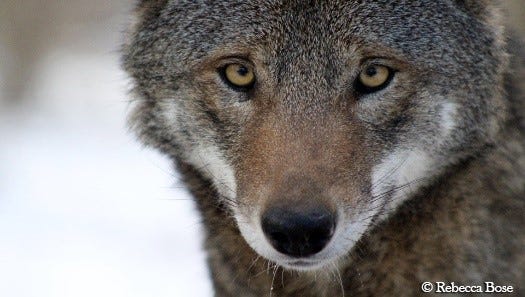For every endangered species, the road to recovery is anything but straightforward. On paper, it may seem black and white, but in reality, it’s not just a matter of numbers or years—it’s a matter of modest successes, small setbacks, hard-earned lessons, and, above all, unwavering commitment. Few species better embody this long road to recovery than the world’s most endangered canine: the Red Wolf. This essay explores the history of the Red Wolf and its remarkable return to the wilds of the Southeastern United States.
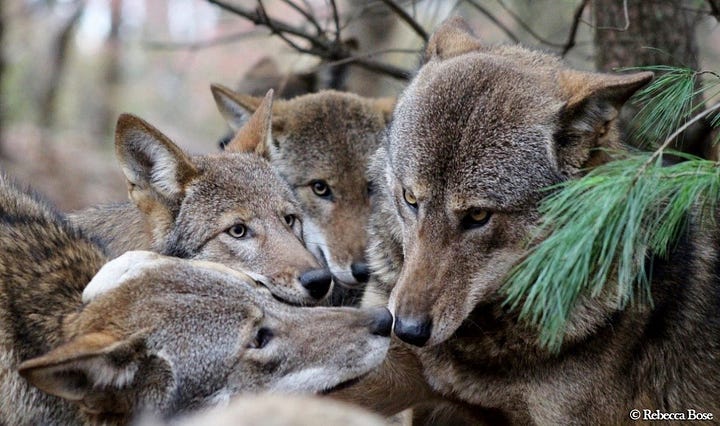
1600s to 1960s: Persecution
The Red Wolf was one of the first animals to suffer at the hands of European settlers. Armed with an anti-wolf fervor bordering on the religious, colonizers set about cleansing the land of fur and fang, with devastating efficiency.
Despite posing little threat to people or livestock, the Red Wolf was poisoned, bombed with dynamite, tortured, and shot in an extermination campaign that lasted centuries. As of the early 1900s, the species had been lost throughout virtually its entire historical range, which once extended from South Florida, onto the edge of the Great Plains, and up into the Ohio River valley.
1970s: On the Brink of Extinction
In 1973, the Endangered Species Act (ESA) was enacted with bipartisan support, and the Red Wolf was included as one of the first listed species. But by that time, the South’s native wolf had become a phantom. The few survivors could only be found in the swampy, inhospitable borderlands of Louisiana and Texas. After conducting a thorough search, led by Curtis Carley, the US Fish and Wildlife Service (FWS) quickly realized that the Red Wolf was not only scarce, but on the verge of disappearing forever. In a last-ditch effort, Carley captured the remaining wolves — a mere 14 individuals — and removed them to Point Defiance Zoo and Aquarium to jumpstart a captive breeding population.
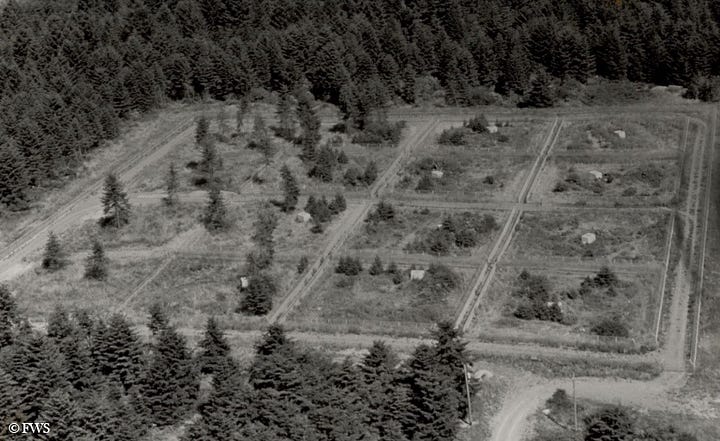
Carley’s bold move ultimately saved the species and put it on the long, winding road to recovery. Various additional zoos stepped forward and the captive stock quickly grew.
After stabilizing the breeding population, FWS quickly set its sights on returning the Red Wolf to the wild, among the pine forests and swamps of the Southeastern coastal plain.
The first step was to determine where and how they could do so.
Bulls Island, located within the heart of the Cape Romain National Wildlife Refuge in South Carolina, provided the perfect opportunity. The island’s small size, as well as its prey density and forest cover, allowed FWS to test their assumptions about an animal few scientists had seen in the wild. The eager support of the South Carolina Wildlife and Marine Resources Department also helped.
In 1976, two wolves were released among the live oaks and pines of the island.
Unfortunately, the female died shortly after of health complications.
FWS was undeterred. After fine-tuning their approach, a second pair was released in 1978. “John” and “Judy” successfully avoided the complications that plagued the first wolf pair. They regularly fed upon deer, birds, and rodents, slept within sand dunes, and endured a series of storms that devastated the coast. Their acclimation eventually confirmed what FWS had hoped: the Red Wolf could be successfully returned to the wild.
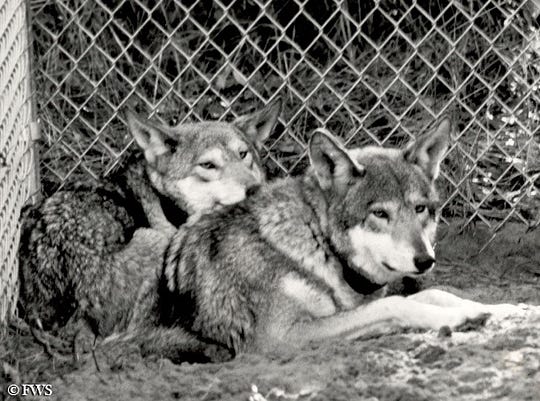
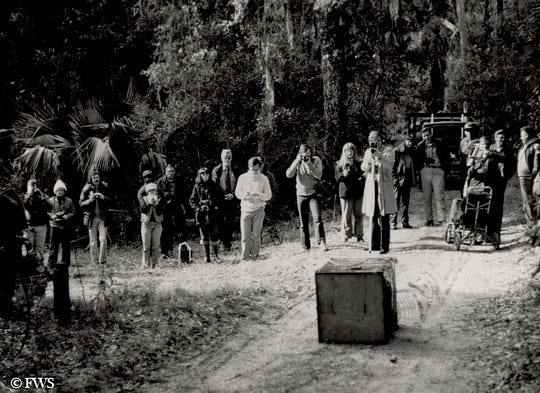

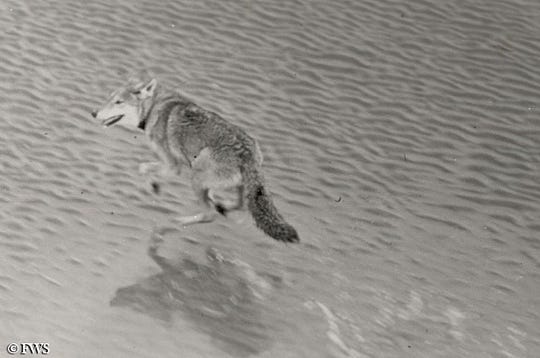
1980 to 1990s: Decades of Innovation
The success on Bulls Island eventually set the stage for a larger-scale reintroduction.
Shortly after “John” and “Judy” established themselves, FWS went about identifying potential sites. Agency leaders initially targeted The Land Between the Lakes (LBL) on the border of Kentucky and Tennessee. There, however, FWS encountered local, anti-government opposition. Some people resented the establishment of LBL and viewed the Red Wolf as another form of “federal overreach.”
FWS promptly scrapped the location.
Fortunately, around that time, Prudential Insurance donated a large chunk of land in Eastern North Carolina that would become the Alligator River National Wildlife Refuge. The refuge’s peninsular location caught the eye of FWS. They also found that it had a manageable social climate — locals were neither for nor wholly against the Red Wolf.
It was within this social context that the first female, “Brindled Hope”, and seven other wolves were released in 1987. That reintroduction marked a global first — aside from the Bulls Island release, no carnivore had ever been reintroduced to the wild. With an abundance of white-tailed deer, raccoon, and rodents to feed upon, they quickly filled the void left by their ancestors and set the stage for what would become a first-of-its-kind success.
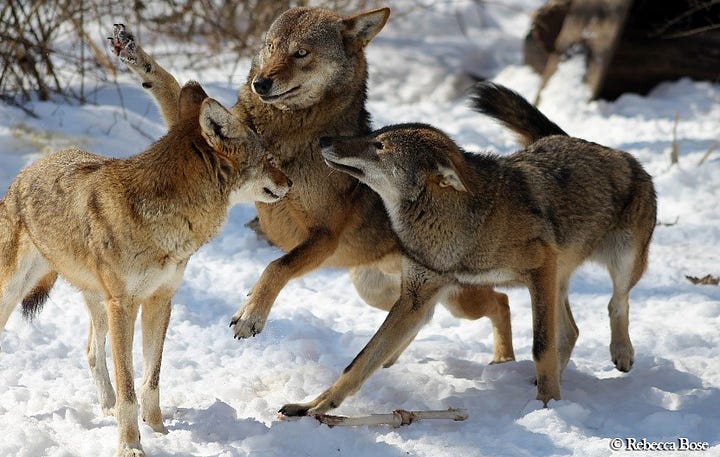
On the heels of this achievement, FWS set about establishing a second population in Great Smoky Mountains National Park five years later.
Unlike the coastal plain, though, the mountains posed several unforeseen biological challenges. For one, parvovirus struck with devastating impacts. The wolves also had difficulty obtaining meals. Individuals regularly left the confines of the park for lower-elevation valleys, where deer were more abundant.
These challenges impeded population growth and, by 1998, FWS had decided to shutter the program in the Smokies. Although classified as a setback, this reintroduction attempt nonetheless provided invaluable insights into the ecology of the Red Wolf.
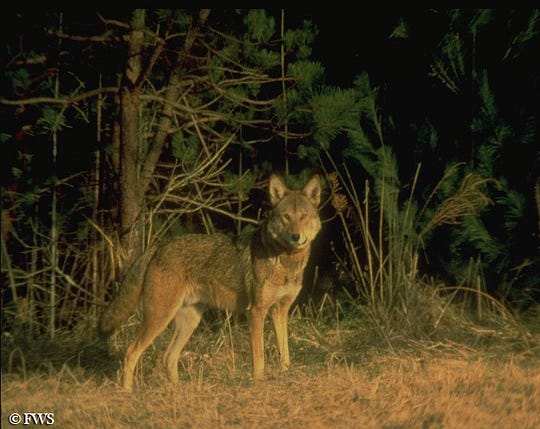

We now know that the Red Wolf best thrives in flat, open terrain. The steep, rugged smoky mountains pose difficulties for pack hunting. The Red Wolf seems to prefer more open spaces near forested edges that offer plenty of space to hunt, cover to hide, as well as ample prey in the form of white-tailed deer.
We’ve also learned more about hybridization, or interbreeding, with their canine cousins, the coyote.
When Carley set out to save the last swamp-dwelling Red Wolves decades ago, he found that many had already paired with coyotes. His team caught nearly 400 canids. The 14 founder animals were the only non-hybridized individuals remaining believed to be pure Red Wolves.
Since then, studies have shown that hybridization occurs as a last resort. Red Wolves do not prefer pairing with their ancestral cousin. Rather, hybridization events typically occur after a wolf family has been torn apart — in most cases, after a breeding wolf is shot. When Red Wolves are in healthy, stable family units, they will either kill or exclude coyotes from their territories. Hybridization management, therefore, is dependent upon managing poaching and human-caused mortality.
2000s: A Story of Hope
Armed with these lessons, FWS eventually accomplished what many once thought impossible. By the mid-2000s, the North Carolina population had swelled to over 150 animals, with another 200 in captivity. At that point, FWS comfortably called the program “remarkably successful,” with the Red Wolf poised for long-term recovery. It was hoped that the “core” population would expand its range beyond the five-county recovery area and down the coastal plain of the Carolinas. Various potential reintroduction sites, including Croatan National Forest in Southeast North Carolina, were also discussed but never solidified. The North Carolina reintroduction celebrated its 20th anniversary in 2007.
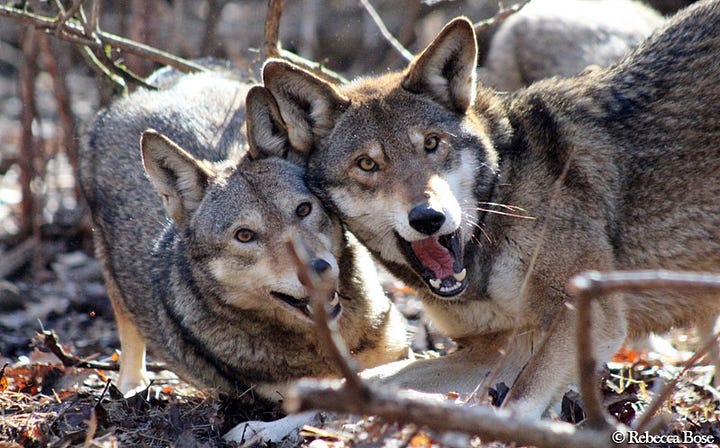
2010s: The Darkest Years
Tragically, the Red Wolf would face its greatest challenges in the years to come.
A key moment occurred when the North Carolina Wildlife Resources Commission (NCWRC) voted to allow the nighttime hunting of coyotes in the Red Wolf Recovery Area. Because Red Wolves are regularly shot as a result of mistaken identity, conservation groups, including Defenders of Wildlife, intervened in court. A settlement was eventually reached in 2014 that allowed coyote hunting during the day, with a permit — a seemingly win-win compromise.
This settlement, however, had the effect of inflaming the territorial Commission. They subsequently revoked their cooperation and called for the extinction of the Red Wolf in the wild. The state’s “leadership” also inspired Senator Thom Tillis and two influential anti-wolf landowners to rally against FWS.
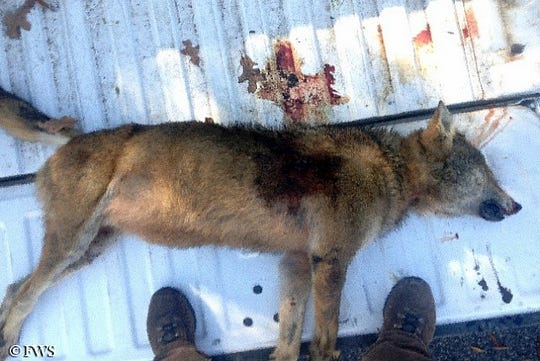
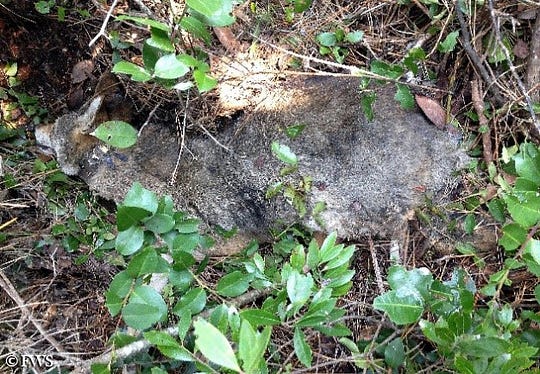
In response to this pressure, FWS administrators in Atlanta made a series of disastrous decisions that continue to the haunt the recovery effort to this day.
- The recovery biologists were stripped of management control. Releases, pup fostering, and collaring were all halted.
- A handful of landowners were permitted to kill non-problem wolves.
- The lead anti-wolf landowner was appointed a seat on the Red Wolf Recovery Team — a panel that Defenders of Wildlife stepped down from in protest.
- Red Wolves were arbitrarily removed from private lands.
- The recovery coordinator was “reassigned.”
- And there was a massive uptick in poaching that went unaddressed.
As a result of this mismanagement, nearly 75 wolves died in just three years. But even those decisions pale in comparison to what followed.
In 2016, on the eve of the reintroduction’s 30th anniversary, FWS stunned the conservation world. Rather than recommitting to the species, FWS instead announced its intention to shrink the Red Wolf Recovery Area by about 90% and force most of the last wolves into zoos. According to scientists, this could result in the extinction of the Red Wolf in the wild in less than a decade.
Future: Recommitment
FWS is expected to make a final decision in the Summer of 2018.
If one thing is for sure, the Red Wolf has repeatedly dodged the chomping jaws of extinction.
Early skeptics initially thought the species was a hopeless, lost cause: a waste of resources. Fast forward 20-odd years, and virtually all involved felt that the Red Wolf was, in fact, a cause for hope. FWS showed the world that, even under the direst of circumstances, we could turn things around.
Although today’s outlook may seem bleak, Defenders of Wildlife is confident that we will again right the ship.
In the coming years, we will continue to devote substantial resources to revitalizing the recovery effort. We hope to work with FWS in stabilizing the North Carolina population, and encourage the establishment of additional populations elsewhere. Through more consistent, on-the-ground education, we plan to address landowner concerns and dispel popular myths. We also intend to positively influence and cooperate with the North Carolina Wildlife Resources Commission, so that the needs of both game and non-game species are addressed.
Above all, we are going to fight to keep the Red Wolf in the wild. Because we believe the Red Wolf is not just an animal of fur and bones, but a sense of place. It is the pine forests in which it dens; the white-tailed deer upon which it feeds; and the night sky into which it howls. Early FWS leaders recognized as much and it’s time for them to do so again.
To help realize our vision, contact FWS Acting Regional Director, Mike Oetker, and encourage him to recommit to the species. North Carolinians must also demand better from the director of the NC Wildlife Resources Commission, Gordon Myers. Tell him that 98.6% of the comments received from NC during the latest public comment period supported the Red Wolf and that the Commission’s anti-wolf stance is out of touch with the wishes of North Carolinians.
Together, we can write the next chapter in the Red Wolf’s story.
Mike Oetker: 404–679–4000; michael_oetker@fws.gov
Gordon Myers: 919–707–0151; gordon.myers@ncwildlife.org
